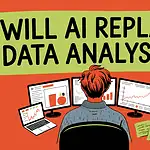If you’ve spent the last year wondering whether AI will take your coding job, you’re not alone. But here’s what’s actually happening in 2025: it’s not just about replacement. It’s way more specific than that.
A Stanford study tracking software engineering employment found a 13% decline in early-career roles for developers aged 22-25. But here’s what most people miss: senior roles haven’t collapsed. They’ve stayed stable or grown.
This isn’t job replacement across the board. It’s task elimination plus market bifurcation.
What does that mean? Routine coding tasks like boilerplate code, simple bug fixes, and basic automation are getting handled by AI faster and cheaper. Those tasks used to be how junior developers learned. Now they’re disappearing.
Meanwhile, roles that require judgment, architecture decisions, debugging complex systems, and shipping actual products? Those are still in demand. The bar just shifted.
Let’s talk about this in detail and see if AI will replace programmers in the near future.
What the 2025 Data Actually Shows
The bifurcation we mentioned? Here’s what it looks like when you actually look at the hiring trends. The market is splitting, and the split has already started showing up in payroll records.
Why Early-Career Roles Are Hit Hardest
Early-career developers (ages 22-25) in AI-exposed fields saw a 13% relative decline in employment since generative AI became mainstream.
Why? The tasks that juniors traditionally do are exactly what AI handles well. Boilerplate code. CRUD operations. Pattern matching. Code that follows a known structure. These are the work junior developers used to cut their teeth on.
Here’s the thing: this isn’t just about job elimination. It’s about the learning pathway. When companies don’t hire juniors, fewer developers develop junior-level skills. And fewer mid-level roles exist later because the pipeline breaks.
Research on code generation productivity shows that AI handles routine tasks faster than any human, but someone still needs to review, refactor, and integrate that code into a larger system.
Senior and Mid-Level Roles Stay Stable or Grow
Meanwhile, experienced developers are fine. BLS employment data shows that workers in the same AI-exposed jobs with more experience have maintained or grown their positions. The Bureau projects software developer employment to grow 17.9% through 2033, much faster than average.
Why does seniority matter? Senior developers aren’t being replaced because they do different work. They manage AI workflows. Review output from code generators. Design architecture. Make decisions about which tasks AI should handle and which shouldn’t. They work with AI as a tool, not in competition with it.
Companies aren’t firing senior devs. They’re hiring fewer juniors because AI absorbs the entry-level work. The senior developer gets to be more productive. But nobody replaces the senior developer’s judgment.
Real Developer Sentiment from Stack Overflow 2025 Survey
Here’s where sentiment gets interesting. 84% of developers use or plan to use AI tools in their workflow. That’s adoption. That’s real.
But only 29% fully trust the output.
That tension matters. Adoption isn’t happening because developers believe AI will make them better programmers. It’s happening because of workflow pressure and competitive anxiety. Everyone else is using it, so you use it too. But the scepticism tells you something: developers know AI generates code that needs checking. Needs fixes. Needs integration. AI creates new work even as it eliminates other work.
Why AI Excels at Junior Work But Struggles with Senior Decisions
Why does this split happen? Because AI and humans are good at different things. Understanding this difference explains why junior roles are shrinking while senior roles stay stable.
What AI Does Well: Boilerplate, Pattern Matching, Routine Tasks
AI excels at tasks with clear patterns and known solutions. Think of it like this: AI learned from millions of code examples. It recognised patterns. Then it got really, really good at repeating those patterns.
Here’s what that looks like in practice:
- Writing boilerplate code (API scaffolding, database connection strings, configuration files)
- Building CRUD operations (Create, Read, Update, Delete)—the repetitive backbone of most apps
- Generating HTML/CSS templates and JavaScript event handlers
- Writing documentation and test stubs
- Converting code from one format to another
These aren’t interesting tasks. They’re the bread and butter of entry-level programming. And they’re exactly what AI was trained to do. According to research on AI-generated code patterns, 79% of AI code interactions are “automation”, routine tasks that follow predictable rules, versus 21% “augmentation,” which involves actual problem-solving.
Why? Because pattern matching is AI’s core strength. It doesn’t need to understand *why* the pattern works. It just needs to recognise the shape and replicate it. For junior developers, this was always 60% of the job. Now, it’s not a job anymore.
What AI Fails At: Architecture, Design, Security Judgment
Here’s where it breaks down. Senior developers don’t spend their time writing boilerplate. They spend it making decisions that have no clear right answer.
These decisions require what we call “tacit knowledge”, stuff you can’t codify into rules. Like:
- Designing system architecture for a product that doesn’t exist yet
- Deciding whether to build something new or refactor existing code
- Choosing between three different technologies based on team skills, budget, and business constraints
- Spotting security vulnerabilities in code that hasn’t broken yet
- Debugging a production issue that crashes only under specific conditions
- Pushing back on a request because it doesn’t align with the codebase’s long-term health
AI can’t do these things well because they require context AI doesn’t have. It doesn’t understand the business. It doesn’t know what the company actually needs (versus what was asked for). It can’t feel the weight of technical debt. And—this is critical—it can’t ask “why?” or challenge bad decisions.
An AI might generate code that introduces a security flaw. A senior dev stops and says, “Wait, why are we doing this? There’s a better way.” That judgment call? That’s what separates a system that barely works from one that scales.
Why Experienced Developers Actually Slow Down
Here’s the thing that contradicts a lot of the hype. Research from MIT and Plain English in 2025 found that experienced developers working with AI tools took 19% *longer* to complete real-world tasks compared to working without them.
This surprises people. But it makes sense once you think about it. Experienced developers don’t use AI output at face value. They read it. They check it for bugs. They verify it fits the existing system. They rewrite the parts that don’t match their style. They ask themselves: “Is this secure?” and “Will this scale?”
That’s context switching. It’s heavy. AI is fast at generating code. But integrating AI output into a codebase that needs to be robust and maintainable? For someone who cares about quality, that’s slower than just writing it yourself.
Junior developers might accept more of the AI output. But they also don’t catch the bugs. That’s exactly why the market is shifting. Routine tasks (junior work) can be automated. Quality assurance (senior work) can’t.
The Real Threat: Task Elimination, Not Job Elimination (Yet)
So what does task elimination look like in practice? It’s not about companies firing experienced developers. It’s far more subtle—and arguably more disruptive.
Why Companies Are Hiring Fewer Juniors
Experienced developers aren’t disappearing from payroll. But junior developers? They’re getting harder to find openings for. Industry surveys show that 54% of organisations report reducing early-career hiring as AI capabilities expand.
The logic is straightforward. If AI can generate boilerplate code, handle basic debugging, and scaffold projects, why hire someone to learn on the job? The work that justified entry-level positions is evaporating. Companies still need software built. They just don’t need as many people learning to build it.
This creates a brutal pipeline problem. In five to ten years, you’ll have fewer developers with that mid-level experience. Not because they were fired—but because fewer people had the chance to build that foundation in the first place.
The Learning Pathway Breaks
Junior work wasn’t just about output. It was about learning. A junior developer used to spend time writing boilerplate code. Boring work, absolutely. But that’s where they internalised patterns, understood system design decisions, and got mentoring from senior code reviews.
When AI eliminates those tasks, mentoring gets squeezed. Reports suggest that 38% of junior developers experience less direct mentoring as routine coding work disappears. Without those learning opportunities, capability gaps widen. Juniors move faster through trivial work but slower through deep understanding.
And senior developers? They get less time to mentor because they’re too busy validating AI output and handling the work that moved up the stack.
More Code, More Responsibility
For developers who do get hired or survive this transition, the work shifts. They ship more code, faster. But someone has to validate it. That someone is usually a senior developer.
Developer satisfaction research shows mixed signals. Some developers love the shift toward judgment-based work. Others find constant code review exhausting. But the change is undeniable. Less time writing routine code. More time ensuring quality, making architectural calls, and debugging AI-generated output that doesn’t quite fit.
Who’s Actually at Risk (And Who’s Gaining Ground)
Based on the data we gathered, here’s who AI is impacting the most, be it risk or help:
1. Early-Career Developers: The Specialisation Window
Junior developers with 0-3 years of experience are watching the job market tighten. The entry-level positions that used to exist in abundance, writing CRUD endpoints, basic form validation, routine database queries, are increasingly handled by AI tools or absorbed into broader roles. This sounds dire, but there’s a crucial flip side.
The developers gaining traction are those who pair junior-level tenure with specialised skills. Think of a junior developer with database architecture knowledge, or one who understands API security deeply, rather than one who just knows how to write code. The specificity matters because AI handles generalist junior work efficiently. It doesn’t handle nuanced problem-solving yet.
What this means for early-career devs: narrow your focus early. Build depth in one or two areas. The multiplier effect kicks in when you combine fresh energy with rare skills.
2. Mid-Level Developers: The Adoption Divide
Mid-level developers—the 3-7 year crew—are bifurcating into two distinct groups. Those adopting AI as a core part of their workflow are expanding their output and taking on more complex projects. Those treating it as optional are watching their relative value flatten.
The multiplier effect is real here. When you’re 5 years in and you’ve mastered your craft, adding AI amplifies what you can already do well. You ship faster. You handle more edge cases. You mentor while coding. The skills compound. For developers resisting the shift, the opposite happens—their output stays steady while the market’s expectations rise around them.
This isn’t about job security today. It’s about relative positioning. Mid-level developers who are thriving right now have already integrated AI into their decision-making process, not as a crutch, but as a thinking partner.
3. Senior Developers: Strong Demand, Higher Barriers
Senior developers remain in high demand. Layoff rates for this tier have stayed comparatively low. Salary premiums for senior roles continue to grow, driven by the fact that few people reach this level and organisations still need experienced leadership.
The catch: the barrier to entry is rising. You can’t coast into a senior role on seniority alone anymore. You need to understand system design, architectural tradeoffs, and increasingly, how to integrate AI-assisted development into team workflows. The title still carries weight, but the skills required to justify it are expanding.
Senior developers who understand both traditional software architecture and modern AI-assisted workflows are becoming a rare commodity. That’s where the premium salaries live.
What the Developers are Saying
What are developers actually saying about all of this? The conversation is messier than any single take suggests.
The reality is that developers fall into three distinct camps. These aren’t theoretical positions—they’re born from real project work and real frustration or satisfaction with the tools in their hands. And they disagree.
The Sceptics – “I Don’t Trust The Code”
A significant portion of developers remain unconvinced. They’re using AI tools, but with heavy scepticism. The core issue? Code quality and the time spent fixing what AI produces.
Developer surveys show that only about 4 out of every 100 developers report both low hallucination rates and high confidence in shipping AI code without human review. That’s telling. Most developers see AI output as a starting point, not a finished product.
These sceptics describe their workflow this way: AI generates code quickly, but review overhead eats up the time savings. They spend hours testing, debugging, and rewriting. Context gets lost. Edge cases get missed. The patterns you’d catch immediately in a code review need manual review.
Their concern isn’t theoretical. It’s grounded. When you’re shipping to production, code that looks right but has hidden bugs is worse than writing it from scratch.
The Optimists – “This Is Making Me Better”
Meanwhile, other developers have a genuinely different experience. For them, AI has changed how they work—for the better.
Surveys show that most developers do use AI regularly in their workflows. The top reported benefit? Increased productivity. These developers aren’t evangelists trying to sell you on AI. They’re just people who started using it and found it worked.
The pattern: they assign boilerplate and repetitive tasks to AI, then focus on the interesting problems. Architecture decisions, debugging complex logic, designing systems. That’s where their time goes now. They report feeling happier. More satisfied. Less burnt out. A common perspective across forums: “I get to think about the hard stuff instead of grinding through scaffolding.”
For them, this isn’t about AI replacing thinking. It’s about AI handling the parts that aren’t thinking.
The Pragmatists – “It’s Here, So Adapt”
Then there’s the middle ground. The pragmatists. They’re not celebrating AI as a revolution or dismissing it as hype. They’re treating it like what it is: another tool that changed the job.
“AI is a tool. It’s part of my job now. I can resist it or get good at it.” That’s the pragmatist perspective. They recognise that whether they like it or not, adaptation is the professional path forward. Some organisations have already integrated AI into workflows. More will. Developers who can work effectively with these tools will have an advantage. Those who can’t will face friction.
They’re neither alarmist nor celebratory. They’re just realistic about what’s happening in the industry and what it means for their career.
These three perspectives aren’t wrong or right—they’re all describing real experiences. The sceptic spending hours on code review? That happens. The optimist is shipping faster with cleaner work? That also happens. The pragmatist adapting to change? That’s just professional reality. What matters is that all three are legitimate responses to the same technology.
The Bottom Line
AI is eliminating certain tasks, restructuring hiring, and changing what skills matter most. Junior developers face a tighter job market. Mid-level developers split between thriving adopters and stagnating sceptics. Senior developers remain in demand, but the barrier to entry is rising.
None of this is job replacement in the traditional sense. It’s something more complex: market bifurcation, task elimination, and career path disruption. It’s real. It’s happening now. And it matters for how you approach your career in 2025 and beyond.
The developers adapting quickly—who see AI as a tool to amplify their existing skills rather than a threat to overcome—are positioning themselves well. The ones treating it as optional or resisting it outright are watching their relative value flatten.
This isn’t about whether AI is good or bad. It’s about recognising that the profession is changing and deciding whether you’ll change with it. That’s not a catastrophe. It’s just the nature of working in technology.
A startup consultant, digital marketer, traveller, and philomath. Aashish has worked with over 20 startups and successfully helped them ideate, raise money, and succeed. When not working, he can be found hiking, camping, and stargazing.









